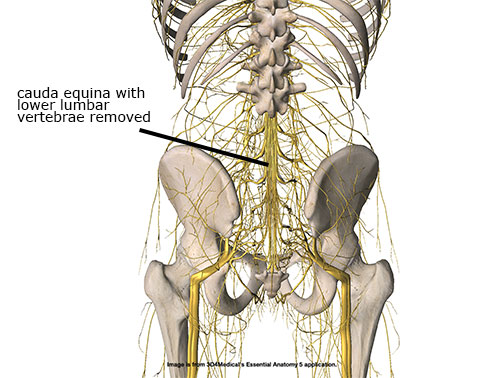Recognizing Cauda Equina Syndrome
- Whitney Lowe
More people than ever before are using massage for a wide variety of ailments, especially back pain. Low back pain is one of the most challenging medical conditions as it is still very difficult to make a direct cause between many low back pain complaints and specific tissue pathology.
Massage can be of great benefit when the primary problem resides in numerous soft tissues such as muscles, fascia, tendons, or ligaments. However, sometimes the client’s condition can be far more serious and it is important to get them to a physician as soon as possible. The massage therapist needs to recognize certain signs and symptoms that could be indicative of a more serious pathology in order to make an appropriate referral.
One such serious condition is called cauda equina syndrome. It is a nerve compression syndrome that occurs in the lumbar region, and it can be very serious. The lower portion of the spinal cord fans out into numerous individual strands in the distal lumbar region and is referred to as the cauda equina, which is translated from Latin to mean horse’s tail (figure).

Cauda equina syndrome occurs when something presses on this bundle of nerve roots in the lower lumbar region. Symptoms can be similar to those from a disc herniation that presses on a single nerve root but there are other unique characteristics that indicate pressure that may be on the entire bundle. The most common cause of cauda equina compression is disc protrusion or rupture. Other causes include spinal tumors, stenosis, local inflammation, fractures, or complications from serious injury such as a car accident, occupational, or sports injury.
The symptoms of cauda equina syndrome include sharp, shooting pain sensations that go down one or both legs. Numbness or weakness in one or both legs may also be present. If there is a disc herniation or other obstruction pressing on a single nerve root, the symptoms are most commonly confined to one leg only. It is more common with cauda equina syndrome for symptoms to be felt down both legs because the pressure is on the central portion of the spinal nerve root fibers, so it gets both sides.
Numerous other symptoms are also reported. Altered sensation or clumsiness in the lower legs may be indicative of nerve compression. It is common for people with cauda equina syndrome to report bowel, bladder, or sexual dysfunction that is of a relatively recent onset. The lower abdominal organ dysfunction is also a result of altered signals from nerve compression.
So what is the role of massage, if any, in addressing cauda equina syndrome? The first issue to determine is whether or not massage is contraindicated. There is no black-and-white answer to this question but as a general guideline massage treatment should never aggravate any of these neurological symptoms. So, if it is aggravating them, the treatment should be ceased or significantly altered. Massage does not put direct pressure on the site of nerve compression, but it can indirectly increase pressure by pushing other structures against the sensitive neurological tissues. Massage is not always contraindicated and there are key benefits massage can offer in reducing excessive sensory irritation. However, if the client is showing symptoms of cauda equina syndrome, it is very important that they get to a physician as soon as possible for an accurate diagnosis because in some cases surgical treatment is needed quickly. Massage can play a part in the postsurgical rehabilitation as well.
As more people are using massage as a means of treating pain and discomfort there is increased importance for the massage therapist to recognize various conditions of pain and dysfunction. You don’t have to be an expert in dozens of orthopedic pathologies, but awareness of some of these more serious conditions is a very important part of appropriate professional practice.

